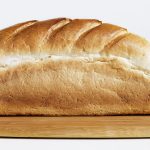 The most amazing fact about the history of the word loaf is not where it came from, but where it went: it became part of two Old English compounds that eventually evolved into the words lord and lady. The word loaf was first recorded in the tenth century, when it was spelt and pronounced hlaf. Back then, loaves of bread were what made the world go round: if you had none, you died, and so the powerful person who supplied you with your loaves came to be known as your hlaf-weard, an Old English compound meaning loaf-ward or guardian of the loaves. Hlaf-weard became hlaford, and then in the fourteenth century was further shortened to lord. The aristocratic counterpart to lord—lady—developed in a similar manner: it began as hlaf-dige, the dige part being an Old English word that meant to knead. The hlaf-dige or loaf-kneader was as important as her husband in so far as she was responsible for making the household’s loaves. Hlaf-dige then became laefdi, before shortening further to lady in the fourteenth century. Other languages have developed titles of respect in similar ways. In Denmark and Sweden, for example, a servant would not call her employer her mistress but rather her madmoder, a term that literally means meat mother. Further back in its history, the Old English hlaf developed from an even older word that meant to rise high, the connection being that a loaf rises while it bakes. Hlaf acquired its modern spelling, loaf, in the fifteenth century.
The most amazing fact about the history of the word loaf is not where it came from, but where it went: it became part of two Old English compounds that eventually evolved into the words lord and lady. The word loaf was first recorded in the tenth century, when it was spelt and pronounced hlaf. Back then, loaves of bread were what made the world go round: if you had none, you died, and so the powerful person who supplied you with your loaves came to be known as your hlaf-weard, an Old English compound meaning loaf-ward or guardian of the loaves. Hlaf-weard became hlaford, and then in the fourteenth century was further shortened to lord. The aristocratic counterpart to lord—lady—developed in a similar manner: it began as hlaf-dige, the dige part being an Old English word that meant to knead. The hlaf-dige or loaf-kneader was as important as her husband in so far as she was responsible for making the household’s loaves. Hlaf-dige then became laefdi, before shortening further to lady in the fourteenth century. Other languages have developed titles of respect in similar ways. In Denmark and Sweden, for example, a servant would not call her employer her mistress but rather her madmoder, a term that literally means meat mother. Further back in its history, the Old English hlaf developed from an even older word that meant to rise high, the connection being that a loaf rises while it bakes. Hlaf acquired its modern spelling, loaf, in the fifteenth century.
A precisely contoured assemblage of a delectable substance, such as bread, cooked meat, sugar, and more, embodies the essence of this description.
